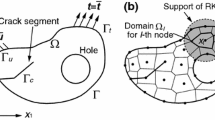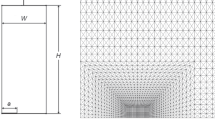Abstract
A novel meshfree discretization technique in terms of the reproducing kernel particle method is presented for accurately evaluating mixed-mode intensity factors of cracked shear-deformable plates. Mindlin–Reissner plate theory is adopted to solve the cracked plates problem in the Galerkin formulation, considering transverse shear deformation. The diffraction method, visibility criterion and enriched basis are included in the generation of meshfree interpolants for the modeling of fracture. In this work, numerical integration is treated using the stabilized conforming nodal integration (SCNI) and subdomain stabilized conforming integration (SSCI). The J-integral (contour integral) is employed to analyze the fracture mechanics parameters. SCNI/SSCI is thus adopted to evaluate the contour integral and to split the original J-integral into symmetric and asymmetric J-integral values. They are calculated by decomposing the smoothed displacement, moment and shear force quantities into symmetric/asymmetric parts. In addition, a displacement ratio method is introduced to divide the asymmetric J-integral value into corresponding moment and shear force intensity factors. The accuracy of the intensity factors and the path-independent properties in mixed-mode fracture problems are critically examined through several numerical examples.


















Similar content being viewed by others
References
Maddox, S.J.: Fatigue Strength of welded Structures, 2nd edn. Abington Publishing, Abington (2002)
Suresh, S.: Fatigue of Materials, 2nd edn. Cambridge University Press, Cambridge (2002)
Fricke, W.: Fatigue analysis of welded joints: state of development. Mar. Struct. 16(3), 185–200 (2003)
Anderson, T.L.: Fracture Mechanics: Fundamentals and Applications, 3rd edn. CRC Press, Boca Raton (2005)
Toyosada, M., Gotoh, K., Niwa, T.: Fatigue crack propagation for a through thickness crack: a crack propagation law considering cyclic plasticity near the crack tip. Int. J. Fatig. 26(9), 983–992 (2004)
Toyosada, M., Gotoh, K., Niwa, T.: Fatigue life assessment for welded structures without initial defects: an algorithm for predicting fatigue crack growth from a sound site. Int. J. Fatig. 26(9), 993–1002 (2004)
Okawa, T., Sumi, Y., Mohri, M.: Simulation-based fatigue crack management of ship structural details applied to longitudinal and transverse connections. Mar. Struct. 19(4), 217–240 (2006)
Sumi, Y., Nakamura, M., Mohri, M.: Crack paths in weld details under combined normal and shear loading. Eng. Fract. Mech. 77(11), 2115–2125 (2010)
He, W., Liu, J., Xie, D.: Numerical study on fatigue crack growth at a web-stiffener of ship structural details by an objected-oriented approach in conjunction with ABAQUS. Mar. Struct. 35, 45–69 (2014)
Qiao, W., Sun, J., Xie, D.: Development of super element to perform direct analysis on failure assessment of hull structures based on FAD. Mar. Struct. 39, 373–394 (2014)
Yao, T., Fujikubo, M.: Buckling and Ultimate Strength of Ship and Ship-like Floating Structures, 1st edn. Butterworth-Heinemann, Oxford (2016)
Hui, C.Y., Zehnder, A.T.: A theory for the fracture of thin plates subjected to bending and twisting moments. Int. J. Fract. 61(3), 211–229 (1993)
Young, M.J., Sun, C.T.: Cracked plates subjected to out-of-plane tearing loads. Int. J. Fract. 60(1), 1–18 (1993)
Viz, M.J., Potyondy, D.O., Zehnder, A.T., Rankin, C.C., Riks, E.: Computation of membrane and bending stress intensity factors for thin, cracked plates. Int. J. Fract. 72(1), 21–38 (1995)
Su, R.K.L., Leung, A.Y.T.: Mixed mode cracks in Reissner plates. Int. J. Fract. 107(3), 235–257 (2001)
Dirgantara, T., Aliabadi, M.H.: Stress intensity factors for cracks in thin plates. Eng. Fract. Mech. 69(13), 1465–1486 (2002)
Aliabadi, M.H.: A new generation of boundary element methods in fracture mechanics. Int. J. Fract. 86(1), 91–125 (1997)
Dolbow, J., Moës, N., Belytschko, T.: Modeling fracture in Mindlin-Reissner plates with the extended finite element method. Int. J. Solid. Struct. 37(48–50), 7161–7183 (2000)
Moës, N., Dolbow, J., Belytschko, T.: A finite element method for crack growth without remeshing. Int. J. Numer. Methods Eng. 46(1), 131–150 (1999)
Wang, Y.H., Tham, L.G., Lee, P.K.K., Tsui, Y.: A boundary collocation method for cracked plates. Comput. Struct. 81(28–29), 2621–2630 (2003)
Zehnder, A.T., Viz, M.J.: Fracture mechanics of thin plates and shells under combined membrane, bending and twisting loads. Appl. Mech. Rev. 58(1), 37–48 (2005)
Nguyen-Thanh, N., Valizadeh, N., Nguyen, M.N., Nguyen-Xuan, H., Zhuang, X., Areias, P., Zi, G., Bazilevs, Y., De Lorenzis, L., Rabczuk, T.: An extended isogeometric thin shell analysis based on Kirchhoff-Love theory. Comput. Methods Appl. Mech. Eng. 284, 265–291 (2015)
Hughes, T.J.R., Cottrell, J.A., Bazilevs, Y.: Isogeometric analysis: CAD, finite elements, NURBS, exact geometry and mesh refinement. Comput. Methods Appl. Mech. Eng. 194(39–41), 4135–4195 (2005)
Yu, T.T., Yin, S., Bui, Q.T., Xia, S., Tanaka, S., Hirose, S.: NURBS-based isogeometric analysis of buckling and free vibration problems for laminated composites plates with complicated cutouts using a new simple FSDT theory and level set method. Thin-Walled Struct. 101, 141–156 (2016)
Yu, T.T., Bui, Q.T., Yin, S., Doan, D.H., Wu, C.T., Do, T.V., Tanaka, S.: On the thermal buckling analysis of functionally graded plates with internal defects using extended isogeometric analysis. Compos. Struct. 136, 684–695 (2016)
Yin, S., Yu, T.T., Bui, Q.T., Zheng, X., Tanaka, S.: In-plane material inhomogeneity of functionally graded plates: a higher-order shear deformation plate isogeometric analysis. Compos. Part B Eng. 106, 273–284 (2016)
Yin, S., Yu, T.T., Bui, Q.T., Liu, P., Hirose, S.: Buckling and vibration extended isogeometric analysis of imperfect graded Reissner–Mindlin plates with internal defects using NURBS and level sets. Comput. Struct. 177, 23–38 (2016)
Sih, G.C. (ed.): Plates and Shells with Cracks, Mechanics of Fracture, vol. 3. Noordhoff International Publishing, Leyden (1977)
Murakami, Y. (ed.): Stress Intensity Factors Handbook. Pergamon Press, Oxford (1987)
Dirgantara, T., Aliabadi, M.H.: Crack growth analysis of plates loaded by bending and tension using dual boundary element method. Int. J. Fract. 105(1), 27–47 (2000)
Dirgantara, T., Aliabadi, M.H.: Numerical simulation of fatigue crack growth in pressurized shells. Int. J. Fatig. 24(7), 725–738 (2002)
Liu, W.K., Jun, S., Zhang, Y.F.: Reproducing kernel particle methods. Int. J. Numer. Methods Fluid. 20(8–9), 1081–1106 (1995)
Wang, D., Chen, J.S.: Locking-free stabilized conforming nodal integration for meshfree Mindlin–Reissner plate formulation. Comput. Methods Appl. Mech. Eng. 193(12–14), 1065–1083 (2004)
Wang, D., Sun, Y.: A Galerkin meshfree method with stabilized conforming nodal integration for geometrically nonlinear analysis of shear deformable plates. Int. J. Comput. Methods 8(4), 685–703 (2011)
Sadamoto, S., Tanaka, S., Okazawa, S.: Elastic large deflection analysis of plates subjected to uniaxial thrust using meshfree Mindlin–Reissner formulation. Comput. Mech. 52(6), 1313–1330 (2013)
Organ, D., Fleming, M., Terry, T., Belytschko, T.: Continuous meshless approximations for nonconvex bodies by diffraction and transparency. Comput. Mech. 18(3), 225–235 (1996)
Krysl, P., Belytschko, T.: Element-free Galerkin method: convergence of the continuous and discontinuous shape functions. Comput. Methods Appl. Mech. Eng. 148(3–4), 257–277 (1997)
Fleming, M., Chu, Y.A., Moran, B., Belytschko, T.: Enriched element-free Galerkin methods for crack tip fields. Int. J. Numer. Methods Eng. 40(8), 1483–1504 (1997)
Joyot, P., Trunzler, J., Chinesta, F.: Enriched reproducing kernel approximation: reproducing functions with discontinuous derivatives. Lect. Notes Comput. Sci. Eng. 43, 93–107 (2005)
Chen, J.S., Wu, C.T., Yoon, S., You, Y.: A stabilized conforming nodal integration for Galerkin meshfree methods. Int. J. Numer. Methods Eng. 50(2), 435–466 (2001)
Chen, J.S., Yoon, S., Wu, C.T.: Non-linear version of stabilized conforming nodal integration for Galerkin mesh-free methods. Int. J. Numer. Methods Eng. 53(12), 2587–2615 (2002)
Wang, D., Chen, J.S.: A Hermite reproducing kernel approximation for thin-plate analysis with sub-domain stabilized conforming integration. Int. J. Numer. Methods Eng. 74(3), 368–390 (2008)
Wang, D., Lin, Z.: Free vibration analysis of thin plates using Hermite reproducing kernel Galerkin meshfree method with sub-domain stabilized conforming integration. Comput. Mech. 46(5), 703–719 (2010)
Wang, D., Lin, Z.: Dispersion and transient analyses of Hermite reproducing kernel Galerkin meshfree method with sub-domain stabilized conforming integration for thin beam and plate structures. Comput. Mech. 48(1), 47–63 (2011)
Wang, D., Lin, Z.: A comparative study on the dispersion properties of HRK and RK meshfree approximations for Kirchhoff plate problem. Int. J. Comput. Methods 9(1), 1240015 (2012)
Tanaka, S., Sadamoto, S., Okazawa, S.: Nonlinear thin-plate bending analyses using the Hermite reproducing kernel approximation. Int. J. Comput. Methods 9(1), 1240012 (2012)
Wang, D., Peng, H.: A Hermite reproducing kernel Galerkin meshfree approach for buckling analysis of thin plates. Comput. Mech. 51(6), 1013–1029 (2013)
Rigby, R.H., Aliabadi, M.H.: Mixed-mode J-integral method for analysis of 3D fracture problems using BEM. Eng. Anal. Bound. Elem. 11(3), 239–256 (1993)
Tanaka, S., Suzuki, H., Sadamoto, S., Sannomaru, S., Yu, T., Bui, Q.T.: \(J\)-integral evaluation for 2D mixed-mode crack problems employing a meshfree stabilized conforming nodal integration method. Comput. Mech. 58(2), 185–198 (2016)
Tanaka, S., Suzuki, H., Sadamoto, S., Imachi, M., Bui, Q.T.: Analysis of cracked shear deformable plates by an effective meshfree plate formulation. Eng. Fract. Mech. 144, 142–157 (2015)
Stephen, N.G.: Mindlin plate theory: best shear coefficient and higher spectra validity. J. Sound Vib. 202(4), 539–553 (1997)
Sosa, H.A., Eischen, J.W.: Computation of stress intensity factors for plate bending via a path-independent integral. Eng. Fract. Mech. 25(4), 451–462 (1986)
Sosa, H., Herrmann, G.: On invariant integrals in the analysis of cracked plates. Int. J. Fract. 40(2), 111–126 (1989)
Liu, D.S., Cheng, K.L., Zhuang, Z.W.: Development of plate infinite element method for stress analysis of elastic bodies with singularities. J. Mech. 29(3), 481–492 (2013)
Liu, D.S., Chiou, D.Y.: A coupled IEM/FEM approach for solving elastic problems with multiple cracks. Int. J. Solid. Struct. 40(8), 1973–1993 (2003)
Liu, D.S., Chiou, D.Y.: Modeling of inclusions with interphases in heterogeneous material using the infinite element method. Comput. Mater. Sci. 31(3–4), 405–420 (2004)
Liu, D.S., Chiou, D.Y.: 2-D infinite element modeling for elastostatic problems with geometric singularity and unbounded domain. Comput. Struct. 83(25–26), 2086–2099 (2005)
Joseph, P.F., Erdogan, F.: Bending of a thin Reissner plate with a through crack. J. Appl. Mech. 58(3), 842–846 (1991)
Acknowledgments
This research was partially supported by the JSPS Grants-in-Aid for Young Scientists (B)(16K18323) and for Scientific Research (A)(15H02328), (B)(15H04212), (B)(16H04603), (C)(15K06632). This work was performed as part of the Cooperative Research Program of the Joining and Welding Research Institute, Osaka University. Tinh Quoc Bui gratefully acknowledges support from Grant-in-Aid for Scientific Research - JSPS. TT Yu gratefully acknowledges support from the National Natural Science Foundation of China (51179063) and the National Sci-Tech Support Plan of China (2015BAB07B10).
Author information
Authors and Affiliations
Corresponding author
Rights and permissions
About this article
Cite this article
Tanaka, S., Suzuki, H., Sadamoto, S. et al. Accurate evaluation of mixed-mode intensity factors of cracked shear-deformable plates by an enriched meshfree Galerkin formulation. Arch Appl Mech 87, 279–298 (2017). https://doi.org/10.1007/s00419-016-1193-x
Received:
Accepted:
Published:
Issue Date:
DOI: https://doi.org/10.1007/s00419-016-1193-x




